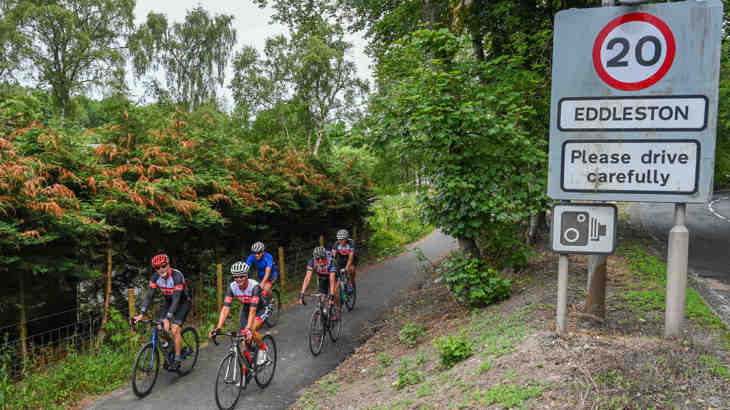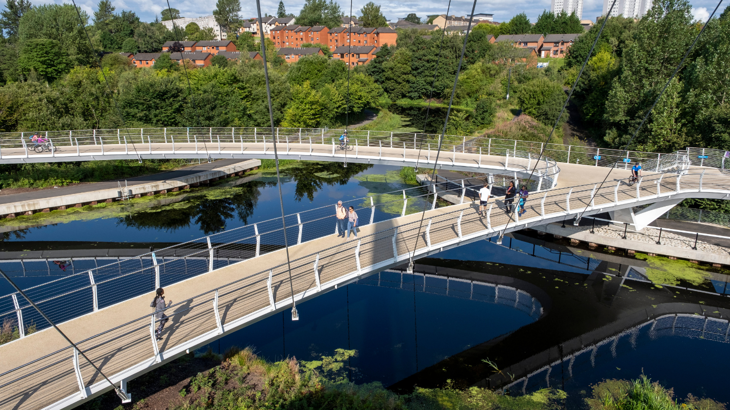A new report by Sustrans shows that walking, wheeling and cycling could cut around a quarter of car emissions in Scotland. In this blog, Karen McGregor, Director of Sustrans Scotland, explains the positive impact the switch to active travel could have on communities and the environment.

A new report from Sustrans Scotland looks into the carbon emissions savings from active travel. Credit: MacAteer Photography
If every journey under three miles in Scotland in 2019 was made by active travel, this would save around a quarter (23-28%) of carbon emissions from cars, research by Sustrans has found.
This excludes emergency vehicles and cars owned by people living with disabilities.
In 2019, over a third (40%) of trips under three miles in Scotland were made using a car or van.
Relying on cars for getting around poses a big problem, especially as Scotland has set itself an ambitious target of reaching net zero emissions by 2045.
For years, emissions from transport, especially cars, have persistently remained at alarmingly high levels, making domestic transport the single largest source of emissions in the country.
But what if we transform the way we travel and reduce our reliance on motor vehicles?
Making a positive, real life impact across Scotland’s communities
In the fight against climate change, active travel plays a small yet fundamentally important role.
In fact, there’s no net-zero without it.
Our modelling work suggests that swapping just 40% of car journeys under three miles to active travel would have reduced 2019 carbon emissions from cars by nearly 10%.
Plus, when compared to many other mitigation options, switching from cars to walking, wheeling and cycling, combined with public transport, stands out as a cost-effective and quick solution.
Investing in walking, wheeling and cycling has already had a profound impact on local communities in Scotland.
Earlier this year, we celebrated the opening of a new off-road, shared-use path between the county town of Peebles and the satellite village of Eddleston in the Scottish Borders.
The project was made possible by more than £2 million of funding from the Scottish Government through Sustrans Scotland’s Places for Everyone programme and South of Scotland Enterprise (SOSE).
The path, which is just under four-miles long, connects communities, businesses and key services like never before, giving local people the choice to leave the car at home for everyday journeys.

The new Eddleston Water Path is an example of sustainable infrastructure. Credit: Scottish Borders Council
Integrating public transport is essential for achieving net zero
Almost all public transport journeys include a walk, wheel or cycle to or from the stop or station.
This means integrating public transport with active travel will boost both means of transport.
In cities like Glasgow, forward-thinking projects such as the new Stockingfield Bridge are connecting communities, enhancing public transport, and reducing the environmental footprint of commuting.
Sustrans supported the project through our Places for Everyone scheme, which is backed by the Scottish Government.
While it may be more difficult to swap long car journeys with active travel, many longer trips could - and should - shift towards a combination of public transport and sustainable travel connections.
Swapping just one longer trip away from car use can often have a bigger impact on emissions than swapping several shorter trips due to the greater distances involved.
For example, travelling by a combination of bike and rail from Edinburgh to Inverness will have a bigger impact than a week of cycling three miles to and from work.
Even a modest shift of 10% of car trips over three miles to public transport and active travel would represent a 7% reduction in emissions.

Integrating public transport links with active travel is key. Credit: MacAteer Photography
More walking, wheeling and cycling leads to a healthier population
The positive effects of embracing active travel go beyond the environment.
Increased levels of walking, wheeling and cycling will mean people are healthier, ultimately resulting in a reduced burden on the healthcare system and fewer hospital visits.
According to our 2021 Walking and Cycling Index, walking and cycling in index cities prevents 4,055 serious long-term health conditions each year.
As more and more research shows, active travel creates healthier, sustainable and more connected communities.
So, if we’re serious about meeting our climate goals, we must take action on car pollution – and fast.
Here are five things you can do in your local area to help protect the environment.
Discover projects that are helping people to choose sustainable travel in Scotland.





